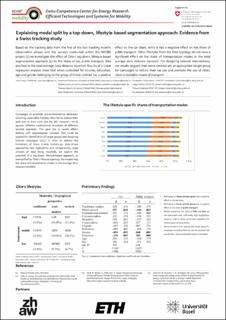Please use this identifier to cite or link to this item:
https://doi.org/10.21256/zhaw-24634Full metadata record
| DC Field | Value | Language |
|---|---|---|
| dc.contributor.author | Tomic, Uros | - |
| dc.contributor.author | Schoeman, Beaumont | - |
| dc.contributor.author | Tchervenkov, Christopher | - |
| dc.contributor.author | Molloy, Joseph | - |
| dc.contributor.author | Dubernet, Thibaut | - |
| dc.contributor.author | Castro, Alberto | - |
| dc.contributor.author | Götschi, Thomas | - |
| dc.contributor.author | Hintermann, Beat | - |
| dc.contributor.author | Axhausen, Kay | - |
| dc.date.accessioned | 2022-03-17T10:05:49Z | - |
| dc.date.available | 2022-03-17T10:05:49Z | - |
| dc.date.issued | 2020-11-23 | - |
| dc.identifier.uri | https://digitalcollection.zhaw.ch/handle/11475/24634 | - |
| dc.description.abstract | Based on the tracking data from the first of the two tracking months (observation phase) and the surveys conducted within the MOBIS project [1] we investigate the effect of Otte’s top‐down, lifestyle‐based segmentation approach [2] on the share of car, public transport, bike and foot in the total average daily distance travelled. Results of a linear regression analysis show that when controlled for income, education, age and gender belonging to the group of home‐centred has a positive effect on the car share, while it has a negative effect on the share of public transport. Other lifestyles from the Otte typology do not have a significant effect on the share of transportation modes in the total average daily distance travelled. For designing tailored interventions, our results suggest that home‐centred are an appropriate target group for campaigns to reduce their car use and promote the use of other, more sustainable means of transport. | de_CH |
| dc.language.iso | en | de_CH |
| dc.publisher | Swiss Competence Center for Energy Research | de_CH |
| dc.rights | Licence according to publishing contract | de_CH |
| dc.subject.ddc | 380: Verkehr | de_CH |
| dc.title | Explaining modal split by a top-down, lifestyle-based segmentation approach : evidence from a Swiss tracking study | de_CH |
| dc.type | Konferenz: Poster | de_CH |
| dcterms.type | Text | de_CH |
| zhaw.departement | School of Engineering | de_CH |
| zhaw.organisationalunit | Institut für Nachhaltige Entwicklung (INE) | de_CH |
| dc.identifier.doi | 10.21256/zhaw-24634 | - |
| zhaw.conference.details | 7th SCCER Mobility Annual Conference, Online, 23 November 2020 | de_CH |
| zhaw.funding.eu | No | de_CH |
| zhaw.originated.zhaw | Yes | de_CH |
| zhaw.publication.status | publishedVersion | de_CH |
| zhaw.publication.review | Not specified | de_CH |
| zhaw.funding.zhaw | MOBIS: Förderung des nachhaltigen Mobilitätsverhaltens mittels Mobility Pricing und informationaler Anreize | de_CH |
| zhaw.author.additional | Yes | de_CH |
| zhaw.display.portrait | Yes | de_CH |
| Appears in collections: | Publikationen School of Engineering | |
Files in This Item:
| File | Description | Size | Format | |
|---|---|---|---|---|
| 2020_Tomic-etal_Explaining-modal-split_SCCER.pdf | 343.88 kB | Adobe PDF |  View/Open |
Show simple item record
Tomic, U., Schoeman, B., Tchervenkov, C., Molloy, J., Dubernet, T., Castro, A., Götschi, T., Hintermann, B., & Axhausen, K. (2020, November 23). Explaining modal split by a top-down, lifestyle-based segmentation approach : evidence from a Swiss tracking study. 7th SCCER Mobility Annual Conference, Online, 23 November 2020. https://doi.org/10.21256/zhaw-24634
Tomic, U. et al. (2020) ‘Explaining modal split by a top-down, lifestyle-based segmentation approach : evidence from a Swiss tracking study’, in 7th SCCER Mobility Annual Conference, Online, 23 November 2020. Swiss Competence Center for Energy Research. Available at: https://doi.org/10.21256/zhaw-24634.
U. Tomic et al., “Explaining modal split by a top-down, lifestyle-based segmentation approach : evidence from a Swiss tracking study,” in 7th SCCER Mobility Annual Conference, Online, 23 November 2020, Nov. 2020. doi: 10.21256/zhaw-24634.
TOMIC, Uros, Beaumont SCHOEMAN, Christopher TCHERVENKOV, Joseph MOLLOY, Thibaut DUBERNET, Alberto CASTRO, Thomas GÖTSCHI, Beat HINTERMANN und Kay AXHAUSEN, 2020. Explaining modal split by a top-down, lifestyle-based segmentation approach : evidence from a Swiss tracking study. In: 7th SCCER Mobility Annual Conference, Online, 23 November 2020. Conference poster. Swiss Competence Center for Energy Research. 23 November 2020
Tomic, Uros, Beaumont Schoeman, Christopher Tchervenkov, Joseph Molloy, Thibaut Dubernet, Alberto Castro, Thomas Götschi, Beat Hintermann, and Kay Axhausen. 2020. “Explaining Modal Split by a Top-down, Lifestyle-Based Segmentation Approach : Evidence from a Swiss Tracking Study.” Conference poster. In 7th SCCER Mobility Annual Conference, Online, 23 November 2020. Swiss Competence Center for Energy Research. https://doi.org/10.21256/zhaw-24634.
Tomic, Uros, et al. “Explaining Modal Split by a Top-down, Lifestyle-Based Segmentation Approach : Evidence from a Swiss Tracking Study.” 7th SCCER Mobility Annual Conference, Online, 23 November 2020, Swiss Competence Center for Energy Research, 2020, https://doi.org/10.21256/zhaw-24634.
Items in DSpace are protected by copyright, with all rights reserved, unless otherwise indicated.